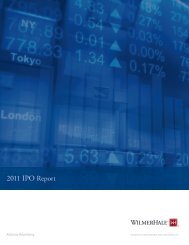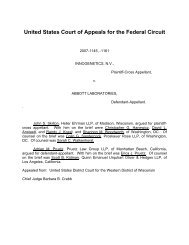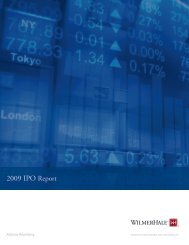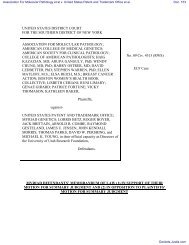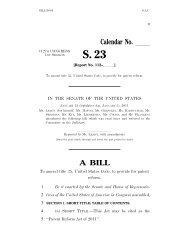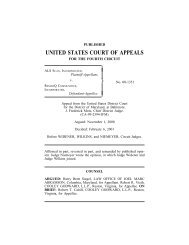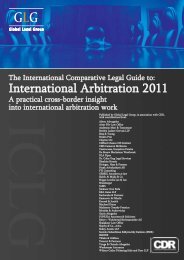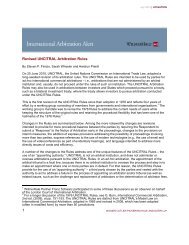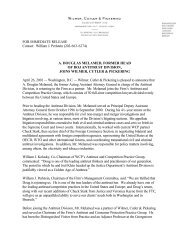2008 IPO Report - Initial Public Offerings
2008 IPO Report - Initial Public Offerings
2008 IPO Report - Initial Public Offerings
You also want an ePaper? Increase the reach of your titles
YUMPU automatically turns print PDFs into web optimized ePapers that Google loves.
<strong>2008</strong> <strong>IPO</strong> <strong>Report</strong>Attorney Advertising
Table of Contents26810121415161920US <strong>IPO</strong> Market Review and OutlookLaw Firm and Underwriter RankingsRegional <strong>IPO</strong> Market Review and Outlook– California– Mid-Atlantic– New England– Tri-StateSelected WilmerHale <strong>Public</strong> <strong>Offerings</strong>New SEC Rules Offer Some Relief to Smaller <strong>Public</strong> CompaniesDual Track <strong>IPO</strong>s – Pursuing Parallel Paths to Liquidity<strong>IPO</strong>s by Special Purpose Acquisition CompaniesPIPEs and Rule 144A Market Review and OutlookRecent Developments in the Proxy Environment<strong>IPO</strong>s – Then and Now
US <strong>IPO</strong> Market Review and Outlook2007 ReviewUS <strong>IPO</strong>s – 1996 to 2007With 207 offerings, gross proceedsof $46.5 billion and a median offeringsize of $119.4 million, the 2007 US <strong>IPO</strong>market was the largest since 2000, if onlyby a slim margin. Compared to 2006,results reflected a 5% increase in thenumber of offerings and a 15% jump ingross proceeds, as the median deal sizereached the highest level on record.While the annual deal totals over thelast four years—averaging 200 <strong>IPO</strong>s peryear—suggest that the <strong>IPO</strong> market mayhave reached a new plateau at roughly twoand one-half times the level that prevailedbetween 2001 and 2003, the weakeningmarket and economic conditions seenat year-end in 2007 have persisted into<strong>2008</strong>, clouding this year’s outlook.US issuers86698768619975221996 1997Source: SEC filingsForeign issuers53757353 480433101998 1999446107339200091 75 7114 9 1077 66 612001 2002 2003205 190 198 20734 32 35 58171 158 163 1492004 2005 2006 2007The number of offerings by US-basedissuers declined 9%, from 163 in 2006to 149 in 2007, reflecting the lowest totalsince 2003. Gross proceeds, however,increased 6%, from $29.4 billion in2006 to $31.3 in 2007, due to a declinein smaller offerings and an increase inthe dollar volume attributable to billiondollarofferings. The number of <strong>IPO</strong>sbelow $50 million fell from 37 to 22, andmedian deal size by US issuers increasedfrom $100.8 million to $105.0 million.Despite concerns that the more stringentregulatory and compliance environmentin the United States might discourageforeign-based issuers from listing on USexchanges, US <strong>IPO</strong>s by foreign issuersincreased 66%, from 35 in 2006 to 58in 2007—the highest annual total since2000. Gross proceeds increased 40%,from $10.9 billion to $15.3 billion, whilethe median deal size declined from$200.0 million to $190.4 million.Chinese issuers produced a whopping31 <strong>IPO</strong>s in the US in 2007, with grossproceeds of $6.2 billion, representingmore than half of all deals and proceedsfrom foreign-issuer <strong>IPO</strong>s. Two high-profileChinese <strong>IPO</strong>s occurred outside of theUnited States, signaling the emergingstrength of Chinese stock exchanges—China Railway Construction raised $5.4billion on the Shanghai Stock Exchange,US <strong>IPO</strong> Dollar Volume – 1996 to 200748.810.038.81996US issuers Foreign issuers $ billions28.9Source: SEC filings59.78.730.8 32.1199740.81998and Alibaba.com pocketed $1.49billion on the Hong Kong StockExchange. Far behind China werethe next-highest generators of foreignissuerUS <strong>IPO</strong>s, Bermuda and Israel,with six each, and Greece with four.Foreign Country Rankings – 2000 to 2007China 72Israel 34Bermuda 31Canada 24Greece 1595.333.761.61999108.252.755.5200041.39.132.2200125.46.419.0200215.26.19.1200346.539.0 31.440.415.38.7 5.2 10.930.326.229.4 31.32004200520062007The energy-related industry sectorled the <strong>IPO</strong> market for the thirdconsecutive year, with 35 <strong>IPO</strong>s, or 16%of the total—up from 30 <strong>IPO</strong>s (15%of the total) in 2006. Other leading sectorswere biotechnology/pharmaceuticalswith 25 <strong>IPO</strong>s (12%), healthcare/medicaldevices with 21 <strong>IPO</strong>s (10%), andsoftware with 20 <strong>IPO</strong>s (also 10%).The number of <strong>IPO</strong>s by technology-relatedcompanies increased 27%, from 84 in 2006(42% of the total) to 107 in 2007 (52%of the total). Gross proceeds raised fromtech-related <strong>IPO</strong>s soared by nearly 50%,
US <strong>IPO</strong> Market Review and Outlookfrom $9.9 billion (25% of the total)to $14.7 billion (32% of the total).Percentage of Profitable <strong>IPO</strong> Companies – 1998 to 2007%Venture-backed <strong>IPO</strong>s jumped from 56in 2006 to 75 in 2007, representing halfof all offerings by US-based issuers, andtheir gross proceeds doubled from $3.70billion to $7.40 billion. On the otherhand, <strong>IPO</strong>s by private equity–backedcompanies slumped in 2007.5626 2652616559626462The percentage of profitable companiesgoing public decreased from 64% in 2006to 62% in 2007, mirroring the average forthe prior five years, and in sharp contrastto the 26% in both 1999 and 2000. Themedian annual revenue of <strong>IPO</strong> companiesdecreased from $111.1 million to $87.0million, primarily due to an increase insmaller tech‐related companies. When the<strong>IPO</strong> market was its most selective, between2001 and 2003, the median annual revenueof <strong>IPO</strong> companies averaged $168.5 million.19981999Source: <strong>IPO</strong> Vital Signs20002001200220032004200520062007Although the capital markets shed someof their gains during the fourth quarter,the Dow gained 6.4% in 2007 and Nasdaqended the year up 9.8%. The average2007 <strong>IPO</strong> ended the year 14.8% aboveits offer price—well below the 24.4%return in 2006. The average first day gain,moreover, was 14.3%, leaving aftermarketperformance essentially flat.Median Annual Revenue of <strong>IPO</strong> Companies – 1998 to 2007$ millions267.5At year-end, 55% of 2007 <strong>IPO</strong>s weretrading at or above their offering price,compared to 70% in 2006. In 2007, 40deals were up more than 50% at year-endand 14 had doubled in price—almostexactly equal to the comparable numbersin 2006. Five of the ten best-performing<strong>IPO</strong>s of 2007 were by Chinese issuers,led by solar cell manufacturer JA SolarHoldings, which ended the year 365%above its <strong>IPO</strong> price. Rounding out the topthree were Argentina’s Mercadolibre,which hosts the largest online tradingplatform in Latin America (up 311%),and Chinese photovoltaic producer YingliGreen Energy (up 252%).No company saw its stock price doubleon opening day, but athenahealth—whichprovides Internet-based business servicesfor physician practices—came close(up 97%). An additional 18 companiessaw their stock price increase at least 50%on the first day of trading.35.01998Source: <strong>IPO</strong> Vital Signs17.9 17.619992000161.02001The best-performing <strong>IPO</strong> sectorsof 2007 were energy-related, with 35 <strong>IPO</strong>sgaining an average of 33% by year-end,and software, with 20 <strong>IPO</strong>s increasing26% on average by year-end.California maintained its dominantposition atop the <strong>IPO</strong> state rankingswith 44 offerings, followed byMassachusetts, which experienceda resurgent tech <strong>IPO</strong> market, with 20.Texas enjoyed a steady flow of energyrelated<strong>IPO</strong>s, with 18, while New Yorkproduced seven <strong>IPO</strong>s, and Oklahomaand New Jersey generated six each.2002144.5200385.72004105.9 111.12005State Rankings – 2000 to 2007California 347Texas 95Massachusetts 89New York 88Illinois 452006In 2007, 68 <strong>IPO</strong>s (33% of the total)were completed by companies basedin the eastern United States (east of theMississippi River), while western US–basedissuers accounted for 83 <strong>IPO</strong>s (40%), andforeign issuers accounted for the remaining58 <strong>IPO</strong>s (28%). Eastern US <strong>IPO</strong>s raised87.02007
US <strong>IPO</strong> Market Review and Outlook$15.6 billion (33% of the total), westernUS <strong>IPO</strong>s raised $16.8 billion (35%) andforeign issuer <strong>IPO</strong>s raised $15.3 billion(32%) of the year’s <strong>IPO</strong> proceeds.The percentage of <strong>IPO</strong> companies listingon Nasdaq—the preferred listing choicefor many venture-backed and technologycompanies—edged down from 65%in 2006 to 62% in 2007, while the NYSE’smarket share increased from 31% to 36%.Average <strong>IPO</strong> offering size for companieslisting on Nasdaq increased from $124.7million in 2006 to $126.6 million in 2007,while the average <strong>IPO</strong> offering size forcompanies listing on the NYSE climbedfrom $387.4 million to $400.3 million.Median <strong>IPO</strong> Offering Size – 1996 to 2007$ millions30.0199633.01997Source: SEC filings36.0199861.0199984.02000115.5 116.420012002119.0200390.72004102.62005113.02006119.42007<strong>2008</strong> OutlookIn broad terms, the US <strong>IPO</strong>market of the past 15 years or sohas gone through four phases:■1991 to 1998—Reasonably stablemarket, producing an averageof more than 550 <strong>IPO</strong>s per yearVenture Capital–Backed <strong>IPO</strong>s – 1996 to 2007■1999 and 2000—Go-go marketcharacterized by many unqualified<strong>IPO</strong> companies and rampant priceeuphoria (although annual dealvolume was about 15% lower thanin the preceding eight years)216# of deals Median amount raised prior to <strong>IPO</strong> (in $ millions)25220146.9 47.8 49.060.273.252.058.066.0■2001 to mid-2003—Very selectivemarket, in which deal volume fellto historic lows and <strong>IPO</strong> candidateswere held to much higher standards15.012013.06822.431.322 18 2367435675■Mid-2003 through 2007—Solidmarket recovery, although notapproaching the deal volumes thatprevailed for most of the 1990sViewed through this lens, the <strong>IPO</strong>market of the late 1990s was as aberrantas the market that immediately followedit. We remain fundamentally optimisticabout the long-term prospects forthe <strong>IPO</strong> market, but <strong>2008</strong> is likely to bea challenging year for several reasons:■Capital Market Conditions: Stableand robust capital markets are a leadingindicator of <strong>IPO</strong> activity. In 2007,the Dow produced solid returns butfell short of its 2006 performance, duein part to a 4.5% decline in the fourth19961997Source: Dow Jones VentureOne1998199920002001quarter, which followed an all-time highin early October. Despite a modest dipin the fourth quarter, Nasdaq toppedits 2006 performance. The Dow shedanother 7.5% in the first quarter of <strong>2008</strong>,while Nasdaq plummeted 14.1%. Manyobservers consider the markets’ prognosisfor the balance of the year to be mixed.■Economic Growth: Economic growthis a key determinant of strength inthe capital markets. After the technologyfueledboom sputtered to an end in early2001, economic recovery was largelydriven by strong consumer spending,boosted by low interest rates, tax cuts20022003200420052006and increased borrowing against homeequity as housing values soared. By late2007, however, the US economy beganto sour. Currently adverse economicfactors include record-high petroleumprices, rising food prices, the continuingdecline in the housing market, ongoingturmoil in the credit markets, thepersistence of some core inflation,and the expense of continuing overseasmilitary conflicts.Impact of Regulatory EnvironmentCorporate governance reformsin the United States have created new2007
US <strong>IPO</strong> Market Review and Outlookresponsibilities for public companiesand their directors and officers.These changes have helped improveaccountability to stockholders, boardoversight of management, board memberqualifications and investor confidence—but have also increased the cost of beingpublic, both in terms of potential liabilityand the expense of compliance.In the near term, the new corporategovernance environment may deter some<strong>IPO</strong> candidates, steer them to liquiditythrough acquisitions or incent themto pursue <strong>IPO</strong>s in markets outside ofthe United States. Offshore <strong>IPO</strong>s by UScompanies have grown as a percentageof all US company <strong>IPO</strong>s worldwide,increasing from less than 5% in eachyear prior to 2004, to 10.9% in 2006and 13.4% in 2007. In the longer term,however, we believe that corporategovernance changes will be assimilatedinto <strong>IPO</strong> planning and not pose a majorimpediment for most companies wishingto pursue <strong>IPO</strong>s in the United States.Venture Capital PipelineVenture capitalists depend on <strong>IPO</strong>s—along with company sales—to provideliquidity to investors. Although a largenumber of VC-backed companies arein <strong>IPO</strong> registration, many of theseofferings are on hold. Longer term,the pool of <strong>IPO</strong> candidates will be affectedby current trends in venture capitalinvesting, including the timeline frominitial funding to <strong>IPO</strong>. According to DowJones VentureOne, the median amountinvested from initial equity financingto <strong>IPO</strong> increased from $58 million in 2006to $66 million in 2007, and the timefrom initial equity financing to <strong>IPO</strong>increased from 6.2 years to 7.1 years.Private Equity ImpactPrivate equity investors also seekto divest portfolio companies or achieveliquidity through <strong>IPO</strong>s. PE-backedcompanies are usually larger and moreseasoned than VC-backed companiesor other start-ups pursuing <strong>IPO</strong>s,and thus can be strong candidates ina demanding <strong>IPO</strong> market. The turmoilin the credit markets and sharp reductionin buyout activity that began in late2007 will probably dampen the flowof PE-backed <strong>IPO</strong> candidates in <strong>2008</strong>.
Law Firm and Underwriter RankingsEastern US <strong>IPO</strong>s – 1996 to 2007Counsel to the IssuerCounsel to the UnderwritersWilmer Cutler Pickering Hale and Dorr LLP8686172Skadden, Arps, Slate, Meagher & Flom LLP5162113Cravath, Swaine & Moore LLP137891Testa, Hurwitz & Thibeault, LLP256691Davis Polk & Wardwell107686Latham & Watkins LLP254974Dewey & LeBoeuf LLP195271Shearman & Sterling LLP155570Simpson Thacher & Bartlett LLP3136 67Ropes & Gray LLP135063Brobeck, Phleger & Harrison LLP233356Morgan, Lewis & Bockius LLP431356Goodwin Procter LLP351651Sidley Austin LLP103949Sullivan & Cromwell LLP74148Source: SEC filingsEastern US Technology Company <strong>IPO</strong>s – 2004 to 2007Counsel to the IssuerCounsel to the UnderwritersWilmer Cutler Pickering Hale and Dorr LLP201333Ropes & Gray LLP41216Goodwin Procter LLP13215Cravath, Swaine & Moore LLP11112Latham & Watkins LLP5712Davis Polk & Wardwell1111Dewey & LeBoeuf LLP1111Wilson Sonsini Goodrich & Rosati, P.C.2911Shearman & Sterling LLP3710Skadden, Arps, Slate, Meagher & Flom LLP3710Mintz, Levin, Cohn, Ferris, Glovsky and Popeo, P.C.437DLA Piper US LLP336Hogan & Hartson LLP415Morgan, Lewis & Bockius LLP415Morrison & Foerster LLP235Pepper Hamilton LLP055Source: SEC filingsThe above charts are based on companies located east of the Mississippi River.
Law Firm and Underwriter RankingsIssuer Counsel in US <strong>IPO</strong>s – 1996 to 2007Wilson Sonsini Goodrich & Rosati, P.C.213Cooley Godward Kronish LLP131Brobeck, Phleger & Harrison LLPWilmer Cutler Pickering Hale and Dorr LLP9195Latham & Watkins LLPHeller Ehrman LLPSkadden, Arps, Slate, Meagher & Flom LLPDLA Piper US LLP72717066Vinson & Elkins L.L.P.61Morgan, Lewis & Bockius LLP53Kirkland & Ellis LLPFenwick & West LLPPillsbury Winthrop Shaw Pittman LLPGunderson Dettmer Stough Villeneuve Franklin & Hachigian, LLPGoodwin Procter LLP4845424138Source: SEC filingsBookrunner in US <strong>IPO</strong>s – 1996 to 2007Credit Suisse389Goldman, Sachs & Co.335Morgan Stanley299Banc of America Securities LLC285Merrill Lynch & Co., Inc.Citigroup Inc.JPMorgan & Co.268262258Lehman Brothers, Inc.232Deutsche Bank Securities Inc.200UBS Investment Bank179Bear Stearns & Co. Inc.110Friedman, Billings, Ramsey & Co., Inc.81Cowen and Company, LLCPrudential Securities, Inc.Piper Jaffray Companies575464Source: Thomson Reuters
Regional <strong>IPO</strong> Market Review and OutlookCaliforniaCalifornia produced 43 <strong>IPO</strong>s with grossproceeds of $5.73 billion in 2007. Theseresults reflect a 23% increase in dealsand a 34% jump in gross proceeds from2006, but remain well below the levelsof <strong>IPO</strong> activity between 1996 and 2000,when California averaged 130 <strong>IPO</strong>s and$9.05 billion in gross proceeds annually.The California <strong>IPO</strong> market remainsdominated by technology-relatedcompanies, with 37 tech <strong>IPO</strong>s accountingfor 86% of the total number of offeringsin 2007. California tech <strong>IPO</strong>s nearlymatched the nationwide tech <strong>IPO</strong>aftermarket performance in 2007, butnon-tech deals underperformed. Theaverage California tech <strong>IPO</strong> ended the year14% above its offering price, comparedto the national average of 15%. Non-tech<strong>IPO</strong>s in California declined 2% on average,compared to an average gain of 16% forall non-tech <strong>IPO</strong>s nationwide.While the perceived heavy burdensof public company compliance and anactive M&A market for venture-backedcompanies continued to restrain <strong>IPO</strong>growth in 2007, the uptick in <strong>IPO</strong> activitysuggests that the market is becoming moreaccustomed to the new regulatory regime.We believe it also reflects the strengthand resiliency of the capital marketsoverall, the effect of private equity buyoutactivity and resultant portfolio companyexits, an active venture capital investmentclimate, and stable earnings growthby more venture-backed companies.Although <strong>2008</strong> began with some signsof a market correction and a significantdecline in private equity buyout activity,we believe that California <strong>IPO</strong> activitywill remain strong, as emerging companiesdemonstrate growth in revenue andprofitability, and newer markets—suchas biotechnology, clean energy technology,wireless applications and services, andcross-border US/Asia deals—expandand mature.Mid-AtlanticThe number of <strong>IPO</strong>s in the mid-Atlanticregion of Virginia, Maryland, NorthCalifornia <strong>IPO</strong>s – 1996 to 2007# deals180106Source: SEC filingsMid-Atlantic <strong>IPO</strong>s – 1996 to 2007# deals66Source: SEC filings1691312515 181996 1997 1998 1999 2000 2001 2002 2003 2004 2005 2006 2007454622262451996 1997 1998 1999 2000 2001 2002 2003 2004 2005 2006 2007Carolina, Delaware and the District ofColumbia declined from 13 in 2006 to 10in 2007. Gross proceeds dipped from $1.34billion in 2006 to $1.25 billion in 2007.Virginia led the region with five <strong>IPO</strong>sin 2007, followed by Marylandand North Carolina with two each.The top-performing mid-Atlantic <strong>IPO</strong>sof the year were by comScore (up 98%from its offering price by year-end)and Sucampo Pharmaceuticals (up 59%).There were seven technology-related<strong>IPO</strong>s in the mid-Atlantic region in 2007,745411251535134310$ billions6.844.51$ billions3.4217.5712.902.151.56 1.371996 1997 1998 1999 2000 2001 2002 2003 2004 2005 2006 20071.563.362.402.633.822.750.96 0.93representing 70% of the total, comparedto 10 (77%) in 2006 and seven (47%)in 2005, demonstrating the region’scontinued focus on the IT and life sciencessectors. The average mid-Atlantic tech <strong>IPO</strong>ended the year up 16% from its offeringprice, while the average non-tech <strong>IPO</strong> sawa decrease of 23%.6.274.282.892.954.271.341.251996 1997 1998 1999 2000 2001 2002 2003 2004 2005 2006 2007In <strong>2008</strong>, we expect the region’s <strong>IPO</strong>candidates to include additionalinformation technology and lifesciences companies, as well as softwareand wireless companies.5.73
Regional <strong>IPO</strong> Market Review and OutlookNew EnglandNew England enjoyed its best year since2000, producing 23 <strong>IPO</strong>s with $3.03 billionin gross proceeds in 2007, compared to 13<strong>IPO</strong>s and $1.99 billion in gross proceedsin 2006. The number of New England <strong>IPO</strong>sin 2007 topped the number from 1998, thebeginning of the bubble, and representedmore than a five-fold increase over the levelof <strong>IPO</strong> activity in the 2001–2003 period.Massachusetts contributed the lion’sshare of the region’s <strong>IPO</strong>s in 2006 (20of the 23). New England retained its highconcentration of technology-relatedactivity, with 19 tech <strong>IPO</strong>s making up83% of the region’s total. Eight of the techrelated<strong>IPO</strong>s came from biotech or medicaldevice companies and four were fromsoftware companies—two sectors oftraditional strength in New England.Underscoring the strength of tech-related<strong>IPO</strong>s in 2007, the region produced seven<strong>IPO</strong>s that had proceeds in excess of $100million: athenahealth ($113.2 million),Constant Contact ($107.2 million), Insulet($115.5 million), Monotype Imaging($132.0 million), Netezza ($108.0 million),Starent Networks ($126.4 million) andTechTarget ($100.1 million). The averageNew England tech <strong>IPO</strong> ended the yearup 21% from its offering price, while theaverage non-tech <strong>IPO</strong> in the regionperformed even better—up 23%.We expect that continued strong levelsof venture capital investment in NewEngland, along with the region’s worldrenowneduniversities and researchinstitutions, will continue to providea fertile environment for new companiesand <strong>IPO</strong> candidates. If market conditionsare conducive in <strong>2008</strong>, we anticipate<strong>IPO</strong>s from technology and life sciencescompanies based in New England—and from Massachusetts in particular.Tri-StateThe number of <strong>IPO</strong>s in the tri-state regionof New York, New Jersey and Pennsylvaniadeclined 53%, from 36 in 2006 to 17in 2007, but gross proceeds edged downonly 5%, from $8.51 billion to $8.08billion. Average deal size in the regionspiked from $236.4 million in 2006New England <strong>IPO</strong>s – 1996 to 2007# deals7934Source: SEC filingsTri-State <strong>IPO</strong>s – 1996 to 2007# deals22Source: SEC filings464135 41996 1997 1998 1999 2000 2001 2002 2003 2004 2005 2006 20071328445893214 131996 1997 1998 1999 2000 2001 2002 2003 2004 2005 2006 2007to $475.3 million in 2007, boosted by threevery large <strong>IPO</strong>s by private equity firms:Blackstone ($4.13 billion), Fortress ($634.3million) and Och-Ziff ($1.15 billion).In addition to six <strong>IPO</strong>s by financialservices companies—the leading sectorin the region—the tri-state regionproduced six <strong>IPO</strong>s in various technologysectors, including biopharmaceuticals,healthcare and wireless. The region alsosaw three energy-related <strong>IPO</strong>s, includingOcean Power Technologies, which becameone of the few US companies to completean <strong>IPO</strong> in the United States after initially4929162513362317$ billions3.632.59$ billions0.873.648.041.025.460.40 0.531996 1997 1998 1999 2000 2001 2002 2003 2004 2005 2006 20078.255.739.5314.755.439.357.070.612.765.37 5.171996 1997 1998 1999 2000 2001 2002 2003 2004 2005 2006 20071.998.51listing on the London AIM market.The average tech <strong>IPO</strong> in the tri-stateregion ended the year down 9% fromits offering price, while the average nontech<strong>IPO</strong> in the region inched up 2%.Venture capital activity in the tri-stateregion now trails only that of Californiaand New England. We expect thatthe region’s VC-backed companies—including technology and life sciencescompanies—as well as spinoffs fromthe region’s established companies,will continue to produce a healthycrop of <strong>IPO</strong> candidates in <strong>2008</strong>.
Counsel of Choice for <strong>Public</strong> <strong>Offerings</strong>SERVING INDUSTRY LEADERS IN TECHNOLOGY, LIFE SCIENCES, FINANCIAL SERVICES, COMMUNICATIONS AND BEYOND<strong>Initial</strong> <strong>Public</strong> Offering ofCommon Stock$135,204,000Counsel to Issuer<strong>Public</strong> Offering ofPreferred Stock$143,750,000Counsel to Underwriters<strong>Initial</strong> <strong>Public</strong> Offering ofCommon Stock$124,200,000Counsel to Issuer<strong>Initial</strong> <strong>Public</strong> Offering ofCommon Stock$115,115,000Counsel to Underwriters<strong>Public</strong> Offering of3.250% Convertible Senior Notes due 2027$165,000,000Counsel to Issuer<strong>Public</strong> Offering ofCommon Stock$96,153,000Counsel to Underwriters<strong>Initial</strong> <strong>Public</strong> Offering ofCommon Stock$107,200,000Counsel to IssuerJune 2007January 2007July 2007May 2007June 2007April 2007October 2007<strong>Public</strong> Offering ofCommon Stock$60,190,000Counsel to UnderwritersRule 144A Placement of1¼% Convertible Subordinated Notesdue 2010 and 1½% ConvertibleSubordinated Notes due 2012$200,000,000Counsel to Issuer<strong>Initial</strong> <strong>Public</strong> Offering ofCommon Stock$41,616,000Counsel to Issuer<strong>Public</strong> Offering ofCommon Stock$567,525,000Counsel to Issuer<strong>Initial</strong> <strong>Public</strong> Offering ofCommon Stock€6,000,000Counsel to Issuer<strong>Initial</strong> <strong>Public</strong> Offering ofCommon Stock$61,600,000Counsel to Underwriters<strong>Public</strong> Offering ofCommon Stock$44,000,000Counsel to Issuer<strong>Initial</strong> <strong>Public</strong> Offering ofCommon Stock$58,100,000Counsel to IssuerSeptember 2007March 2007November 2007November 2007September 2007August 2007November 2007July 2007<strong>Initial</strong> <strong>Public</strong> Offering ofCommon Stock$250,000,000Counsel to Issuer<strong>Public</strong> <strong>Offerings</strong> ofMedium-Term Notes$9,190,000,000Counsel to Underwriters and AgentsClosed-End Mutual Fund <strong>Public</strong>Offering of Common Stock$203,750,000Counsel to Issuer<strong>Public</strong> Offering ofCommon Stock$138,000,000Counsel to Underwriters<strong>Public</strong> Offering ofOrdinary Shares£7,500,000Counsel to Issuer<strong>Initial</strong> <strong>Public</strong> Offering ofCommon Stock$100,000,000Counsel to Issuer<strong>Public</strong> Offering of0.875% Convertible Senior Notes due 2017$500,000,000Counsel to UnderwritersOctober 2007Various Dates 2007May 2007May 2007October 2007April 2007June 2007BIODEL<strong>Initial</strong> <strong>Public</strong> Offering ofOrdinary Shares£34,700,000Counsel to UnderwritersRule 144A Placement of2.50% Convertible Senior Notes due 2014$125,000,000Counsel to Issuer<strong>Initial</strong> <strong>Public</strong> Offering ofCommon Stock$49,594,000Counsel to Issuer<strong>Public</strong> Offering of5.75% Notes Due 2017$250,000,000Counsel to Underwriters<strong>Public</strong> Offering ofCommon Stock$19,760,000Counsel to Issuer<strong>Public</strong> Offering ofCommon Stock$142,485,000Counsel to Underwriters<strong>Public</strong> Offering ofCommon Stock$99,875,000Counsel to Issuer<strong>Initial</strong> <strong>Public</strong> Offering ofCommon Stock$86,250,000Counsel to UnderwritersApril 2007June 2007August 2007January 2007May 2007May 2007July 2007May 2007
12 New SEC Rules Offer Some Relief to Smaller <strong>Public</strong> CompaniesEffective February 4, <strong>2008</strong>, the SECpromulgated a new set of disclosurerules for “smaller reporting companies”to replace the former “small businessissuer” rules. A smaller reporting companyis eligible to use reduced, or “scaled,”disclosure in the Form S-1 registrationstatement for its <strong>IPO</strong> and in subsequentSEC filings.EligibilityUnder the new rules, a smaller reportingcompany must have a public float of lessthan $75 million. An <strong>IPO</strong> companydetermines its eligibility as of a datewithin 30 days of the initial Form S-1filing. <strong>Public</strong> float is calculated bymultiplying a bona fide estimate of the<strong>IPO</strong> offering price per share (which neednot be disclosed) by the sum of the numberof outstanding shares of common stockheld by non-affiliates before the <strong>IPO</strong> plusthe aggregate number of shares beingregistered for sale in the <strong>IPO</strong>.An existing public company determinesits eligibility by measuring its publicfloat as of the last day of its most recentlycompleted second fiscal quarter. <strong>Public</strong>float is calculated by multiplying themarket price of its common stock bythe number of shares held by non-affiliatesof the company. If the company’s publicfloat is $75 million or more on that date,it cannot qualify as a smaller reportingcompany until such point as its publicfloat as of the last day of a second fiscalquarter falls below $50 million.If the public float of a smaller reportingcompany as of the last day of its secondfiscal quarter rises to $75 millionor more, the company can no longer usescaled disclosure beginning with theForm 10-Q for the first fiscal quarterof the next fiscal year. The company may,however, continue to use scaled disclosurethrough and including the filing of itsForm 10-K for that fiscal year. To regaineligibility thereafter, the company’s publicfloat as of the last day of a second fiscalquarter must fall below $50 million.If a company is unable to calculateits public float—for example, if it has nocommon stock outstanding or no marketprice exists for its outstanding commonstock—it must have had less than $50million in revenue in its most recent fiscalyear to qualify as a smaller reportingcompany. Once its annual revenue exceeds$50 million, the company will lose itssmaller reporting company status untilit has annual revenue of less than $40million in its most recent fiscal year.Scaled DisclosureThe accompanying table summarizesthe scaled disclosure that is availableto smaller reporting companies underRegulation S-K—the source of manydisclosure requirements in SEC filings.In addition, smaller reporting companiesare permitted to provide one fewer yearof audited statements of income, cashflows and changes in stockholders’ equity.Smaller reporting companies are allowedto pick and choose on an item-by-item(referred to as “à la carte”) basis the aspectsof scaled disclosure they wish to follow,and can make this election quarterly.ImplicationsRelatively few <strong>IPO</strong> companies will qualifyas smaller reporting companies, since most<strong>IPO</strong>s—particularly underwritten ones—have an anticipated public float of at least$75 million. Over time, however, somepost-<strong>IPO</strong> companies may find themselveseligible to provide scaled disclosure astheir fortunes—and public floats—wane.Scaled disclosure, if available, can providesignificant savings in terms of expenseand preparation time. The principaladvantages relate to financial statementsand executive compensation disclosure.Smaller reporting companies are notrequired to provide segment information,selected financial data, supplementaryfinancial information or information aboutmarket risk, and can provide one feweryear of audited financial statements andthe associated discussion in MD&A. Scaleddisclosure permits much less extensiveexecutive compensation information,including no CD&A, and requires onlythree of the seven compensation tablesthat would otherwise be required.If a company qualifies as a smallerreporting company, it should considerthe following questions when decidingwhether, and to what extent,it will provide scaled disclosure:■Does the company wish to beperceived by the market as a “smaller”company? If not, the company maywish to forego scaled disclosure.■What disclosures does the company’sinvestor base expect? If the company’sinvestors are largely institutional,they may be dissatisfied by the lessextensive disclosure permitted by thesmaller reporting company rules.■What disclosures are the company’scompetitors making? If the company’sprincipal competitors prepare their SECfilings on the basis of the larger reportingcompany rules, the company may bedisadvantaged if it does not do the same.■Does the company believe that itsstatus as a smaller reporting companyis temporary? If so, the company maywish to eschew scaled disclosureto avoid any issues with the consistencyand comparability of its disclosuresbefore and after its stint as a smallerreporting company.■Have there been any material changesto the company’s financial position,business or executive compensation thatwould be masked by scaled disclosure?If so, the company should consider theSEC’s antifraud rules and be mindfulof any appearance that it is attemptingto hide material information throughthe use of scaled disclosure.■Would scaled disclosure subject thecompany to additional potential liabilityunder the securities laws, or denyit the benefits of additional cautionarydisclosures? For example, althoughsmaller reporting companies mayomit risk factors from Forms 10, 10-Qand 10-K, doing so may be unwise.In the context of an <strong>IPO</strong>, the company’sdecision should be made in consultationwith the lead underwriters. In many cases,the underwriters are likely to concludethat the marketing of the offering wouldbe enhanced if the company were toprovide more comprehensive disclosurein lieu of scaled disclosure.
New SEC Rules Offer Some Relief to Smaller <strong>Public</strong> Companies13Affected Regulation S-K ItemItem 101 (Description of Business)Scaled Disclosure Available to Smaller <strong>Report</strong>ing Companies■A description of the development of the business is only required for three years (as opposed to five).■No segment information is required.■An estimate of the amount spent on research and development activities is only required for two years(as opposed to three).Item 201 (Market Price of and Dividendson the Registrant’s Common Equity and RelatedStockholder Matters)■Stock performance graph is not required.Item 301 (Selected Financial Data)■Not required.Item 302 (Supplementary Financial Information)■Not required.Item 303 (Management’s Discussion and Analysisof Financial Condition and Results of Operations)■Only two years of analysis is required if only two years of financial statements are presented(as opposed to three years of analysis when three years of financial statements are presented).■Tabular disclosure of contractual obligations is not required.Item 305 (Quantitative and QualitativeDisclosures about Market Risk)■Not required.Item 402 (Executive Compensation)■CD&A is not required.■Compensation information is required only for three named executive officers, including the principalexecutive officer (as opposed to five named executive officers, including the principal executive officerand principal financial officer).■Only three of the seven compensation tables required of larger companies must be provided—the SummaryCompensation Table, Outstanding Equity Awards at Fiscal Year End Table and Director Compensation Table.■The Summary Compensation Table is only required to cover two years (as opposed to three).■Footnote disclosure of the grant date fair value of equity awards in the Director Compensation Tableis not required.Item 404 (Transactions with Related Persons,Promoters and Certain Control Persons)■Disclosure of the policies and procedures for reviewing related person transactions is not required.■Disclosure is required for related person transactions where the amount exceeds the lesser of $120,000and 1% of the average of the company’s total assets at the end of its last two completed fiscal years—this test is more stringent than the flat $120,000 threshold for other public companies—and additionalspecific information about underwriting discounts and corporate parents is required that is not requiredfor other public companies.■In registration statements, information is required for the last three completed fiscal years plus the currentfiscal year—the same standard as for other public companies; in other SEC filings, information is requiredfor the last two completed fiscal years plus the current fiscal year—one more year than is requiredfor other public companies.Item 407 (Corporate Governance)■Compensation Committee <strong>Report</strong> is not required.■“Compensation Committee Interlocks and Insider Participation” disclosure is not required.■Disclosure of whether (or why not) the Audit Committee has at least one “Audit Committee FinancialExpert” is not required in the first Form 10-K.Item 503 (Prospectus Summary, Risk Factors,and Ratio of Earnings to Fixed Charges)■Risk factors are not required in Forms 10, 10-Q and 10-K (but remain required in a Form S-1).■Information regarding the ratio of earnings to fixed charges is not required when debt is issued,and information regarding the ratio of combined fixed charges and preferred dividends to earningsis not required when preferred stock is issued.Item 504 (Use of Proceeds)■If offering proceeds will be used to fund an acquisition, the relaxed financial statement requirementsfor a smaller reporting company under Regulation S-X are used to determine whether, and which, financialstatements of the target company must be included.Item 601 (Exhibits)■Exhibit 12 (Statements re Computation of Ratios) is not required.
14Dual Track <strong>IPO</strong>s – Pursuing Parallel Paths to LiquiditySometimes, a company (or itsinvestors) is torn between an <strong>IPO</strong>and a sale. The company may be qualifiedand willing to take on an <strong>IPO</strong>, yet enticedby the prospect of selling and unsure howto compare the relative ease and certaintyof being acquired with the equity upsideof an <strong>IPO</strong>. The choice can pose a quandaryif <strong>IPO</strong> market conditions are choppy,creating execution risk for any <strong>IPO</strong> plan.In these cases the optimum choice maybe a “dual track,” in which the companysimultaneously pursues an <strong>IPO</strong> whileentertaining—or even courting—suitors.Anecdotal evidence suggests dual trackefforts are increasing in frequency, as theperceived burdens of public company lifehave increased and <strong>IPO</strong>s have becomemore difficult to complete. A dual trackstrategy presents various challenges:■Importance of Confidentiality: Evenmore so than usual, the M&A processmust be kept under wraps, to minimizethe risk of premature disclosureand to avoid disruption to the effortand focus demanded of the <strong>IPO</strong> process.■Disclosure Issues: Absent a leak,the sale process usually need not bepublicly disclosed prior to an acquisitionannouncement. A dual track strategycan, however, result in thorny disclosureissues if the company opts for an <strong>IPO</strong>rather than a sale. For example, ifan acquisition deal is reached and thenfalls apart, the company must considerwhether the reasons for the busteddeal must be disclosed in the <strong>IPO</strong>prospectus—this could prompt negativedisclosures and delay an <strong>IPO</strong> whilethe prospectus is supplemented.■Legal Advisor: The company willalmost certainly utilize its <strong>IPO</strong> lawfirm for the M&A track as well—to usedifferent counsel for the two tracks wouldsquander the hard-earned institutionalknowledge from the <strong>IPO</strong> process andcreate logistical and other challenges—but should make sure appropriate M&Aexpertise is available on the companycounsel team for the potential sale.■Selection of Financial Advisors: Thecompany will ordinarily want financialadvisors to handle the sale side of the dualtrack. The <strong>IPO</strong> lead underwriters willknow the company best and be obviouschoices for the M&A engagement. Ifone (but not all) of the lead underwritersis selected as the M&A advisor and theconcurrent sale process is not disclosedto the other lead underwriters,complications can result. Also, theeconomic outcomes may be differentfor financial advisors on a sale transactionthan for underwriters in an <strong>IPO</strong>, whichmay give the selected party or partiesan incentive to steer the process one wayor the other.■Potential for Conflicted Motivations:The company’s management and keyemployees may also have financialincentives to prefer one alternative overthe other. A company sale will often resultin the replacement of top management,particularly the CEO and CFO, but mayalso trigger equity acceleration andchange-in-control and severancepayments. On the other hand, an <strong>IPO</strong>will offer management continuedemployment and the potential for marketappreciation, but without the immediaterealization of change-in-control benefits.The company’s board of directors needsto be conscious of the hazards posedby any skewed incentives, and in somecases may need to make adjustments toachieve the best outcome for stockholders.■Board Duties: The board’s fiduciaryduties to stockholders obviously applywhen considering the choice of an <strong>IPO</strong>or company sale and when evaluatingacquisition offers. The board is notcompelled to accept an acquisitionoffer that is within the estimated <strong>IPO</strong>price range, but the board will want tofollow an appropriate process in a dualtrack, as it would in any sale process.■Valuation Impact: A dual track can createtricky valuation issues for the company.If the company pursues an <strong>IPO</strong> afterreceiving one or more acquisition offers,it must consider the impact of these offerson its subsequent determinations of fairmarket value for option grants made priorto the <strong>IPO</strong>. Similarly, the company willneed to evaluate whether the amountof any acquisition offers should—ormust—be disclosed in response to cheapstock comments from the SEC.■Timing Considerations: Althougha company can pursue both sides ofa dual track strategy for a long time,it eventually must select one alternative.In theory, the day of reckoning canbe delayed until after the <strong>IPO</strong> roadshow and moments before inkingthe underwriting agreement. In reality,the choice is usually made before going onthe road, because a road show is expensiveand time-consuming and underwritersare leery of irritating fund managers withmeaningless presentations. If an attractiveacquisition offer does not seem imminent,the sale process is ordinarily shut downwhen the road show begins.■Sale Terms: If an acceptable acquisitionoffer emerges from a dual track process,the focus will shift to a traditional M&Anegotiation, but with two wrinkles. One,there will be a heightened urgency to signa definitive agreement quickly, so thatthe company does not lose its <strong>IPO</strong>window in the event the sale cannot beconcluded. Two, the company may seekto style the definitive agreement as if thetransaction were a “public-public” merger,with no representations, indemnitiesor escrows following the closing.■Unwinding the <strong>IPO</strong>: Assuming anacquisition agreement is signed after theForm S-1 has been filed, the company’s<strong>IPO</strong> filings will need to be withdrawnprior to closing the sale. Since a dealcan come undone for many reasons,it is usually advisable to keep the FormS-1 and exchange listing applicationon file until shortly before the closing.■Extra Effort and Expense: A dual trackcombines the rigors of an <strong>IPO</strong> withthe effort of a company sale process,and usually in a compressed timeframe. A handful of key participantswill bear the brunt of the extraburden, and the company should seizeefficiency opportunities—such as avirtual data room where due diligencematerials can be made available tounderwriters’ counsel and multiplebidders simultaneously—when available.Although both an <strong>IPO</strong> underwritingdiscount and an M&A success fee willnot be paid, total transaction expensesin a dual track strategy usually exceedthe expenses of either path alone.
<strong>IPO</strong>s by Special Purpose Acquisition Companies15<strong>IPO</strong>s by special purpose acquisitioncompanies, or SPACs, made a bigsplash in 2007. SPACS are developmentstagecompanies formed for the purposeof engaging in a merger or acquisition withan unidentified company or companies.Although the basic concept of a SPACis not new, SPACs only recently beganto enter the <strong>IPO</strong> market in droves.The recent surge in popularity of SPAC<strong>IPO</strong>s can be attributed to several factors,including self-imposed restrictionsto protect investors; the decision of Amexin 2005 to begin accepting SPACs forlisting, enabling them to bypass statesecurities law review; an influx of highcaliberand experienced managementteams and founding sponsors; theinvolvement of bulge-bracket investmentbanking firms and top-tier law firms,helping legitimize SPACs; significantlylarger offering sizes, expanding therange of feasible acquisitions; anda receptive audience among hedge fundinvestors that are flush with cash.CharacteristicsAs SPACs have moved into the <strong>IPO</strong>mainstream, their general characteristicshave coalesced. A typical structurein 2007 consisted of the following,although early indications suggest thatsome key terms will evolve in <strong>2008</strong>:■Securities Offered: In the <strong>IPO</strong>,the SPAC sells units consisting of oneshare of common stock and a warrantto purchase one additional share.In a concurrent private placement, theSPAC’s founding stockholders make asignificant investment in the company.■Underwriting Arrangements: The <strong>IPO</strong>’sunderwriters earn a normal underwritingdiscount but defer a portion of it until anacquisition is consummated. In additionto a standard over-allotment option,the underwriters sometimes are grantedan option to purchase additional units.■Offering Proceeds: At least 95%,and often as much as 97.5% or more,of the proceeds from the <strong>IPO</strong>, plus theproceeds of the founding stockholderinvestment and the deferred underwritingdiscount, are placed “in trust.” The trustaccount is released to the company onlyif a business combination is approved.■Trading Liquidity: SPAC sharesand warrants are freely traded inthe marketplace. Liquidity providesinvestors with an exit strategy,and helps management negotiatea business combination.■Insider Ownership: Insiders owna substantial stake (often 20%) in theSPAC and agree to place their stockin escrow for a period of 6–12 monthsafter the completion of an acquisition.No salaries, finder’s fees or otherkinds of cash compensation are paidto insiders prior to an acquisition.■Proposed Acquisition: Followingthe <strong>IPO</strong>, management searches foran acquisition opportunity with a fairmarket value of at least 80% of theSPAC’s net assets. The SPAC cannotpursue a smaller acquisition, but canissue additional stock or debt to facilitatea larger transaction. If a suitable targetis identified, an acquisition agreementis negotiated and signed, subject toapproval by the SPAC’s stockholders.■Stockholder Approval: The SPAC preparesand distributes a proxy statement tosolicit stockholder approval. The SPACcannot complete the acquisition if amajority of the outstanding shares arevoted against the transaction, or if publicstockholders owning a specified thresholdof the outstanding shares elect to tendershares back to the SPAC in exchange for apro rata distribution from the trust fund.■Liquidation and Return of Funds:If a business combination is notconsummated within 18–24 monthsafter the <strong>IPO</strong>, the SPAC is dissolved, andthe trust account is distributed to publicinvestors. Insiders do not participate inthis distribution, and the underwritersforfeit the deferred portion of their fees.<strong>IPO</strong> ProcessThe <strong>IPO</strong> process for a SPAC isdifferent than for a conventional <strong>IPO</strong>in various respects:■Since a SPAC has no operatinghistory, due diligence is simplerand focused primarily on thecompany’s management arrangementsand its targeted industry sector.■The offering description—the unitstructure, trust account and underwritingarrangements—is significantly morecomplicated than in a common stock<strong>IPO</strong> by an operating company.■The SPAC’s operating structure,including procedures for approvingan acquisition, tendering shares backto the SPAC and liquidatingthe company if a business combinationis not completed within the prescribedtime, will be described in detail.■The prospectus will provide extensiveinformation about the company’sproposed business and sector focusand the criteria to be applied inevaluating potential acquisitions.■Detailed information about thecompany’s arrangements with foundingstockholders and management,including potential conflicts ofinterest, will be included.■Assuming the SPAC was organizedshortly before the initial Form S-1filing, the prospectus will containvery limited financial and executivecompensation information, andprobably no MD&A or CD&A.■The road show will be shorter (perhapsonly one week) and will focus onthe hedge fund investors who are thepredominant buyers of SPAC <strong>IPO</strong>s.■The SPAC will incur the burdenand expense of updating its Form S-1to reflect “fundamental changes” byfiling post-effective amendments as longas the warrants remain exercisable.OutlookSPACs with the type of investor protectionsdescribed above are a relatively recentphenomenon. A large percentage ofSPACs are still in pre-acquisition mode,and the popularity of the SPAC vehiclemay wane if many are liquidated. Otherfactors affecting the availability of hedgefund capital to fund SPACs, and theuniverse of suitable targets for SPACsto acquire, will also help determine thelong-term prognosis for SPAC <strong>IPO</strong>s.
16PIPEs and Rule 144A Market Review and OutlookAn <strong>IPO</strong> is a major milestone for anycompany, but it does not necessarilymean that all future equity capital will beraised through follow-on public offerings.Two popular financing transactions forpublic companies—PIPEs and Rule 144Aplacements—involve private placements.PIPEs deal activity hit another record highin 2007, while the number of Rule 144Aplacements also increased from 2006. Bothare likely to remain desirable andaccessible financing techniques for manycompanies in <strong>2008</strong>, particularly becauseof the flexibility they offer in uncertainmarket conditions.PIPEs Financings – 2001 to 2007# of deals $ in billions1,6411,2941,3261,05522.516.618.4 18.62001200220032004Includes closed deals only.Source: PrivateRaise1,584200523.01,872200638.71,968200769.90PIPEs FinancingsThe PIPEs (Private Investments in <strong>Public</strong>Equity) market surged to record levels onceagain in 2007, boosted by several megadealsfor financial institutions hit hard bythe subprime mortgage crisis. Deal volume,dollar volume and average deal size alljumped significantly, as public companiesof all sizes increasingly tapped the PIPEsmarket to meet their capital needs.Pricing (measured in terms of fixedpricediscounts and warrant terms)for PIPEs issuers improved modestlyin 2007 compared to 2006.The number of PIPEs deals (includingregistered direct offerings) increasedfrom 1,872 in 2006 to a record 1,968in 2007, and dollar volume soared from$38.7 billion to a new high of $69.9billion—topping the size of the Rule144A market for the first time. AveragePIPEs deal size reached a record $35.5million, up from $20.7 million in 2006.In 2007, there were 11 PIPEs financingsraising more than $1 billion each—thetop five closed by financial institutions—compared to only four billion-dollardeals in 2006. The largest PIPEsfinancing in 2007 raised $7.5 billion.Companies with market capitalizationsunder $250 million were responsiblefor 85% of all PIPEs financings in 2007,down from 89% in 2006, while companieswith market caps below $50 millionaccounted for 49% of all PIPEs.Largest PIPEs Financings by Eastern US Life Sciences Companies – 2003 to 2007Issuer Proceeds Issuer Counsel2007Molecular Insight Pharmaceuticals, Inc. $150,000,000 Foley & Lardner LLPInspire Pharmaceuticals, Inc. $75,000,000 Reed Smith LLPAthersys, Inc. $65,000,000 Jones Day2006Keryx Biopharmaceuticals, Inc. $82,800,000 Alston & Bird LLPMomenta Pharmaceuticals, Inc. $75,000,000 Wilmer Cutler Pickering Hale and Dorr LLPNitroMed, Inc. $62,505,000 Wilmer Cutler Pickering Hale and Dorr LLP2005Alnylam Pharmaceuticals, Inc. $58,526,000 Wilmer Cutler Pickering Hale and Dorr LLPCritical Therapeutics, Inc. $54,500,000 Wilmer Cutler Pickering Hale and Dorr LLPDrugMax, Inc. $45,221,000 Sichenzia Ross Friedman Ference LLP2004Neurogen Corporation $100,000,000 Milbank, Tweed, Hadley & McCloy LLPGenome Therapeutics Corp. $88,200,000 Ropes & Gray LLPIdenix Pharmaceuticals, Inc. $75,600,000 Wilmer Cutler Pickering Hale and Dorr LLP2003Penwest Pharmaceuticals Co. $52,663,000 Wilmer Cutler Pickering Hale and Dorr LLPAdvanced Viral Research Corp. $50,000,000 Kirkpatrick & Lockhart Nicholson Graham LLPRegeneron Pharmaceuticals, Inc. $48,000,000 Skadden, Arps, Slate, Meagher & Flom LLPBased on companies located east of the Mississippi River and listed in the following PrivateRaise sectors: biotech and pharmaceuticals.Source: PrivateRaise and SEC filingsThe biotechnology and pharmaceuticalsector produced 13% of all PIPEs deals,with an average deal size of $22.5 million,but was edged out for top billing by themetals, minerals and stones sector (14% ofall deals and an average deal size of $12.9million). Two other sectors each accountedfor at least 5% of the PIPEs market in 2007:
PIPEs and Rule 144A Market Review and Outlook17energy (12% of the market with $56.2million average deal size), and mining(8% and $23.2 million). Medical devicecompanies, which historically havecontributed at least 5% of the PIPEsmarket, slipped to just below 5% in 2007,as average deal size in the sector shrankto $9.1 million.Rule 144A Equity Placements – 2001 to 2007# of deals $ in billions24672.967.316714135.411049.212253.9Of all PIPEs financings in 2007, 63%were common stock (average deal sizeof $28.7 million). The next largestsegments were convertible debt (18%of all PIPEs and $17.1 million averagesize) and convertible preferred stock (8%of all PIPEs and $47.7 million averagesize). This breakdown reflects a continuedshift to common stock deals fromconvertible deals, as investors seek moreprotection in uncertain capital markets.77 25.320012002Includes closed deals only.Source: PrivateRaise2003200481200524.820062007Fixed-price deals continued to dominatethe PIPEs market in 2007, representing88% of all deals, up from 82% in 2006.The percentage of deals with variablepricing—after hovering between 10% and11% each year between 2004 and 2006—dropped by nearly half, to 6% in 2007.The average discount from marketin fixed-price common stock PIPEsdeals slipped to 8.3% in 2007 from 9.3%the prior year (compared to a hefty16% in 2004). Warrant terms on thesedeals were largely unchanged in 2007.The percentage of deals that includedwarrants was 58% (compared to 56%in 2006), the average exercise premiumwas 19% (compared to 22% in 2006)and the average warrant coverage was67% (compared to 65% in 2006).With PIPEs deals firmly ensconcedin the financing mainstream, particularlyfor small-cap and mid-cap issuers, thePIPEs market should continue to play animportant corporate finance role in <strong>2008</strong>.Rule 144A PlacementsThe Rule 144A market for equity securities(including convertible debt) grew againin 2007. The number of placementsand gross proceeds each increased 11%from 2006 levels. The market expansionoccurred even though some convertibledebt deals from very large companies—Largest Rule 144A Equity Placements by Eastern US Technology Companies – 2003 to 2007Issuer Proceeds Issuer Counsel2007NII Holdings Inc. $1,200,000,000 Williams Mullen, P.C.St. Jude Medical, Inc. $1,200,000,000 Dorsey & Whitney LLPGeneral Cable Corporation $475,000,000 Blank Rome LLP2006Medtronic, Inc. $4,400,000,000 Wilmer Cutler Pickering Hale and Dorr LLPEMC Corporation $3,450,000,000 Skadden, Arps, Slate, Meagher & Flom LLPMedImmune, Inc. $1,150,000,000 Dewey Ballantine LLP2005L-3 Communications Holdings, Inc. $700,000,000 Simpson, Thacher & Bartlett LLPIVAX Corporation $350,000,000 Stearns Weaver Miller Weissler Alhadeff & Sitterson, P.A.NII Holdings Inc. $350,000,000 Williams Mullen, P.C.2004Red Hat, Inc. $600,000,000 Wilmer Cutler Pickering Hale and Dorr LLPImClone Systems Incorporated $600,000,000 Davis Polk & WardwellSepracor Inc. $500,000,000 Wilmer Cutler Pickering Hale and Dorr LLP2003Bristol-Myers Squibb Company $1,200,000,000 Cravath, Swaine & Moore LLPWyeth $1,020,000,000 Simpson, Thacher & Bartlett LLPSepracor Inc. $750,000,000 Wilmer Cutler Pickering Hale and Dorr LLPBased on companies located east of the Mississippi River and listed in the following PrivateRaise sectors: aerospace & defense, biotech, computers,Internet, medical devices, pharmaceuticals, semiconductors, software and telco.Source: PrivateRaise and SEC filingsknown as “well-known seasoned issuers”(WKSIs) under SEC rules—probablywere redirected from the Rule 144Amarket to the registered public market.The number of Rule 144A equityplacements increased from 110 in 2006to 122 in 2007, while gross proceedsgrew from $49.2 billion to $53.9 billion.
18 PIPEs and Rule 144A Market Review and OutlookCompany Counsel in Eastern US Rule 144A Equity Placements – 2001 to 2007# of deals Proceeds (in $ billions)Wilmer Cutler Pickering Hale and Dorr LLPSkadden, Arps, Slate, Meagher & Flom LLPSimpson, Thacher & Bartlett LLPLatham & Watkins LLPHogan & Hartson L.L.P.Shearman & Sterling LLPJones DayJones, Walker, Waechter, Poitevent, Carrere & Denegre LLPSidley Austin LLPDavis Polk & WardwellWeil, Gotshal & Manges LLPKramer Levin Naftalis & Frankel LLPMcDermott Will & Emery3.82.21.91.94.03.02.173.471.771.670.910101010988The above chart is based on companies located east of the Mississippi River.Source: PrivateRaise9.0172111.7Average deal size was down slightly, to$442.1 million in 2007 from $447.4 millionthe year before. Results in 2007 benefitedfrom 17 billion-dollar placements,with two deals breaking the $2 billionbarrier. Three of the four largest Rule144A issuers were financial institutionsshoring up their balance sheets.Rule 144A issuers tend to be muchlarger and more mature than issuersin the PIPEs market. Companies withmarket caps above $1 billion accountedfor 67% of Rule 144A placements in2007 but only 3.5% of all PIPEs deals.REITs led the Rule 144A equity marketfor the second consecutive year (with16% of deals and an average deal sizeof $475.3 million), followed by theenergy sector (13% and $203.2 million)and semiconductor companies (8%and $834.0 million). Biotechnologyand pharmaceutical companies, whichgenerally rank at the top of the Rule 144Amarket, slipped from 15% of all deals(with a $628.9 million average deal size)in 2006 to 7% of 2007 deals (with a $314.8million average deal size). Telco companiesalso contributed 7% of the year’s deals,with an average size of $420.6 million,followed by medical devices (5% and$320.0 million). No other sector accountedfor as much as 5% of the market.In 2007, 99% of all Rule 144A equityplacements involved the issuance ofconvertible debt securities, up slightlyfrom 98% in 2006. With only twoplacements, convertible preferredsecurities almost disappeared from theRule 144A market in 2007. SEC rules donot permit public companies to offercommon stock in Rule 144A placements.Seasoned public companies have longrecognized the faster execution time andgreater flexibility afforded by Rule 144Aplacements. WKSIs can now enjoy thesesame advantages with registered publicofferings, while avoiding the expenseand effort of resale registration followinga Rule 144A placement, and without anylimitations on the types of securitiesoffered. Convertible debt offeringsby large-cap issuers can be expectedincreasingly to be structured as registeredpublic offerings, but the Rule 144A marketshould remain an important source ofcapital for many companies.
Recent Developments in the Proxy Environment19Following its <strong>IPO</strong>, a newly publiccompany becomes subject to theSEC’s proxy rules.In the <strong>2008</strong> proxy season, companiesand shareholders will likely experiencesome important changes in the waysthey communicate, influence and,on occasion, clash with one anotherdue to evolving modifications of theSEC’s proxy rules governing shareholdercommunications and proposals.But the dam will not burst this year,because changes in two criticallyimportant areas will not occur until2009 or later. Accordingly, <strong>2008</strong>will be a transitional year in whichsome—but not all—of the emergingregulatory changes will take effect andwill interact with one another in waysthat are now difficult to predict.Regulatory DevelopmentsWhat follows is a brief summaryof some of the most important recentdevelopments that will affect the rightsand obligations of companies andshareholders in <strong>2008</strong> and subsequent years:■Rule 14a-8 Proposals Relating toShareholder Access: In late 2007 theSEC reaffirmed—for the <strong>2008</strong> proxyseason—its longstanding positionthat companies may exclude fromtheir proxy statements any Rule 14a-8proposals (whether binding or precatory)that relate to “shareholder access”procedures allowing shareholders toplace the names of their board nomineesdirectly on the company’s proxy card.■Broker Discretionary Voting: The SECappears likely to leave in abeyance until2009 the New York Stock Exchange’sproposal to prohibit the traditionalpractice of broker-dealers automaticallyvoting street name shares in favor ofcompanies’ slates of director nomineesin uncontested elections in the absenceof specific instructions from the beneficialowners of the shares. Although this isan NYSE proposal, it affects Nasdaqcompanies as well, since the current ruleapplies to voting by all brokers and dealersthat are members of the NYSE, regardlessof where the shares being voted are listed.■<strong>Public</strong> Statements Made on ElectronicForums: New Rules 14a-2(b)(6) and 14a-17exempt statements made by shareholderson electronic shareholder forums frommost requirements of the proxy rules. Inparticular, communications posted on anelectronic forum more than 60 days priorto an annual meeting will be deemedto constitute an exempt solicitationof proxies, even if the shareholdersubsequently commences a proxy contest.■Electronic Delivery of Proxy Statements:New Rule 14a-16 permits all publiccompanies to post their proxy materialson a website—and requires those that are“accelerated filers” to do so. The companymay elect to have this instantaneouselectronic access (“e-proxy”) constitutedelivery of its proxy materials if it notifiesshareholders in writing about the websiteand offers to send a hard copy by mailupon request. E-proxy delivery can alsobe elected by dissident shareholderswhen mounting a proxy contest.Practical ConsequencesEach of these developments is likelyto modify the cost/benefit analysisand probable outcomes of proxy contestsand withhold vote campaigns:■A shareholder access bylaw, if adopted,would typically require a companyto include on its own proxy card thenames of director candidates nominatedby shareholders who held at least aspecified threshold percentage of thecompany’s outstanding shares, togetherwith the same type of biographicaland other information as required forthe candidates recommended by thecompany’s nominating committeeand, typically, a short statement insupport of the candidates. Shareholderaccess would permit eligible dissidentshareholders to deliver their core messageto all shareholders, side by side with thecompany’s disclosures, at the company’sexpense, by whichever method of delivery(e-proxy or traditional) the companyelected to use for its proxy materials.■Broker discretionary voting hashistorically tended to automaticallydeliver large numbers of votes in favorof official slates of director nomineesin uncontested elections. Eliminating thispractice would require many companiesto extend the solicitation period runningup to their annual meeting and/orcause their proxy solicitors to be moreproactive, in order to ensure that aquorum is obtained, and make it harderfor companies that have implementeda majority voting requirement to obtainmajority support for their nominees.■The new exemption for public statementsmade on electronic forums more than60 days prior to an annual meetingwill encourage dissatisfied shareholdersto begin to make their case againstcurrent management and companypolicies—at zero out-of-pocket cost—well in advance of proxy season withoutworrying about compromising theirability to subsequently commencea proxy contest and without havingto make any SEC filings.■The ability to deliver proxy materialsby the e-proxy method may encouragefull-fledged proxy contests (as distinctfrom withhold vote campaigns) becauseit offers dissident shareholders thepossibility of reducing the printingand mailing costs involved in a fullfledgedproxy contest down to a levelnot greatly in excess of some withholdvote campaigns. Use of e-proxydelivery by companies and/or dissidentshareholders will also change thecustomary timeline for a proxy contestin ways that may benefit the dissidents.These developments will not affectall companies in the same manner.For example, the abolition of brokerdiscretionary voting will makeincumbents’ board seats more vulnerableto withhold vote campaigns at companiesthat have adopted majority voting, butwill not have binding effects at companiesthat have not adopted majority voting.On the other hand, the potentially lowercosts associated with e-proxy deliveryand a more flexible timeline for beginninga publicity campaign against incumbentmanagement on electronic forumsmay tend to encourage proxy contestsuniversally and thereby increase thenumber of successful proxy contests.
20 <strong>IPO</strong>s – Then and NowThe tenth anniversary of our annual<strong>IPO</strong> <strong>Report</strong> caused us to reflect a biton the <strong>IPO</strong> market.From a distance, today’s <strong>IPO</strong> processlooks much the same as that of ageneration ago or even 5 to 10 yearsago. In fundamental ways, the processhas scarcely changed—you gather at anorganizational meeting, hold multipledrafting and diligence sessions, file a FormS-1 registration statement with the SEC,resolve SEC comments, pitch investorson a road show, meet at a financialprinter to finalize the prospectus, signthe underwriting agreement, and thenprice and close the deal. But below 30,000feet, many changes become apparent:■More Extensive Preparation: Far morepreparation—legal, accounting, financial,governance and organizational—is nowrequired for an <strong>IPO</strong>, and the work comesearlier in the process. <strong>IPO</strong> candidatesused to select a lead underwriter andhold an organizational meeting to kickoff the <strong>IPO</strong> process, with little advancepreparation. Now, if the company hasnot invested several months or morein getting ready to go public, the <strong>IPO</strong>schedule will lag well behind underwriterexpectations as well as the pace ofother companies in the <strong>IPO</strong> queue.■Additional Disclosure: Disclosurerequirements have mushroomed in recentyears. Companies need to provide muchmore extensive and elaborate disclosurein areas such as MD&A; executivecompensation, including the new CD&A;risk factors; and the financial statementsand footnotes. Much of this stemsfrom new and expanded SEC and stockexchange rules, but other aspects reflectmore demanding investor expectations.As a result of these changes, prospectuseshave ballooned in length, routinelyexceeding 150 pages and requiringsummaries of 5–10 pages or more.■Plain English: Prospectuses are nowwritten in “plain English,” a foreignlanguage to old-school securities lawyerswho trafficked in defined terms, legaljargon, long sentences and even longerparagraphs. Most practitioners willadmit that plain English has beena rousing success, although it is morethan a bit ironic that as prospectuseshave become much simpler to readthey have also become much longer.■Lengthier (but More Transparent) SECReview Process: SEC review now involvesmore comment letters and a lengthierprocess. Whereas it used to be possibleto clear all SEC comments with as fewas one or two letters, three or more setsof comments is now typical. As a result,it is almost unheard of to print redherrings and begin a road show basedon the initial Form S-1 filing or thecompany’s response to the first commentletter alone—a common practice wellinto the 1990s. The SEC now publiclyreleases comment letters and companyresponses after completing its review ofregistration statements, providing bettervisibility into the SEC review process.■Changes in Underwriting Practices:Most <strong>IPO</strong>s now have three or fourmanaging underwriters, but syndicateshave become smaller as investmentbanking firms have become much largerthrough industry consolidation. Roadshows are longer, and frequently includetrips to Europe. Marketing reach isusually expanded with electronic roadshows. The roles of investment bankersand securities analysts are now separatedin the offering process, changingthe way <strong>IPO</strong> companies interact witheach. Free writing prospectuses cannow be used to update information,and post-effective prospectus deliveryobligations can be satisfied with a noticethat the sale was made pursuant to aregistration statement. Standard lockupagreements usually can be extendedif the company announces earningsor material developments toward theend of the initial lockup period.■Longer Timeline: The timeline frominitial Form S-1 filing to closing hasbecome much longer. Prior to 2000or so, an <strong>IPO</strong> candidate could reasonablyexpect to complete the <strong>IPO</strong> within45–60 days after filing. Today’s normis twice that. The longer the <strong>IPO</strong>process, the more opportunities forthe offering to be delayed or scuttleddue to market conditions or companydevelopments, causing many proposed<strong>IPO</strong>s to proceed in fits and starts.■Streamlined Filing and Pricing: The SEC’sEDGAR system has made filing simpler—no more hand deliveries of registrationstatements—and the informationinstantly available to everyone—nomore “quiet” filings. Rule 430A permits aForm S-1 to be declared effective withoutincluding final pricing information,eliminating the mad scramble to geta pricing amendment on file before themarkets open on the first trading day.Rule 462(b) provides for immediateregistration of additional shares, allowingan <strong>IPO</strong> to be readily upsized by upto 20% in aggregate gross proceeds.■Heightened Scrutiny and PotentialLiability: Each director can be heldliable for a material inaccuracyor omission in the Form S-1, subjectto a “due diligence defense.” Followingan <strong>IPO</strong>, the company’s officers signinga periodic SEC report can likewisebe held liable for a material inaccuracyor omission in the report. Now, conductof directors and officers is increasinglyscrutinized, and the Sarbanes-OxleyAct and related SEC rules require thecompany’s CEO and CFO to providepersonal certifications in connectionwith the filing of each Form 10-Q andForm 10-K. Willful false certificationscan result in a fine of up to $5 millionand imprisonment for up to 20 years.■New Exchanges and Offering Formats:Nasdaq has split the Nasdaq NationalMarket into the Nasdaq Global Marketand the Nasdaq Global Select Market, andrenamed the Nasdaq SmallCap Market asthe Nasdaq Capital Market. NYSE hasadded the “Arca” market for smallercompanies and become more aggressivein recruiting small-cap and mid-capcompanies. Both Nasdaq and NYSE havebecome larger and more global throughacquisitions. Overseas, various exchangeshave come and gone. In all markets,online and auction formats have grownwith the expansion of the Internet.■Elimination of Blue Sky Regulation:State securities regulation of <strong>IPO</strong>shas been largely eliminated, as longas the company qualifies for listingon a national securities exchange.Lengthy blue sky memoranda andassociated state filings thus are athing of the past in most <strong>IPO</strong>s.
Want to know moreabout the venture capitaland M&A markets?Our <strong>2008</strong> Venture Capital <strong>Report</strong> offers an in-depthanalysis of the US and European venture capitalmarkets and the outlook for the year ahead.The report features industry and regional breakdowns,an analysis of the VC fund formation climate, andan overview of trends in venture capital financingand VC-backed company M&A deal terms.See our <strong>2008</strong> M&A <strong>Report</strong> for a detailed reviewof the global M&A market and the outlookfor the coming year. In other highlights, we revisitrecent trends in takeover defenses, review the impactof CFIUS on foreign acquisitions of US companies,present a survey of key terms in sales of VC-backedcompanies, examine the ramifications of recentSEC changes to Rules 144 and 145, and discussthe impact of FASB’s adoption of new accountingrules for M&A transactions.For summaries and analysis of compensation datafrom the past year, collected from hundreds ofexecutives and private companies located throughoutthe country, see our 2007 Compensation andEntrepreneurship <strong>Report</strong> in Information Technologyand our 2007 Compensation and Entrepreneurship <strong>Report</strong>in Life Sciences at www.wilmerhale.com/compreports.To request a copy of any of the reportsdescribed above, or to obtain additional copiesof the <strong>2008</strong> <strong>IPO</strong> <strong>Report</strong>, please contact theWilmerHale Marketing and Business DevelopmentDepartment at marketing@wilmerhale.com or call+1 617 526 5600. An electronic copy of this reportcan be found at www.wilmerhale.com/<strong>2008</strong><strong>IPO</strong>report.Data SourcesWilmerHale compiled all data in this report unlessotherwise noted. <strong>Offerings</strong> by REITs, bank conversions,closed-end investment trusts and special purpose acquisitioncompanies are excluded. Offering proceeds excludeproceeds from exercise of underwriters’ over-allotmentoptions, if applicable. For law firm rankings, <strong>IPO</strong>s areincluded under the current name of each law firm. Venturecapital data is sourced from Dow Jones VentureOne.PIPEs and Rule 144A data is sourced from PrivateRaise.© <strong>2008</strong> Wilmer Cutler Pickering Hale and Dorr llp
WilmerHale recognizes its corporate responsibility to environmental stewardship.wilmerhale.comWilmer Cutler Pickering Hale and Dorr llp is a Delaware limited liability partnership. Our United Kingdom offices are operated under a separate Delaware limited liability partnership of solicitors and registeredforeign lawyers regulated by the Law Society of England and Wales. In Beijing, we are registered to operate as a Foreign Law Firm Representative Office. WilmerHale principal law offices: 60 State Street ,Boston, Massachusetts 02109, +1 617 526 6000; 1875 Pennsylvania Avenue, NW, Washington, DC 20006, +1 202 663 6000. This material is for general informational purposes only and does not representour legal advice as to any particular set of facts; nor does it represent any undertaking to keep recipients advised of all relevant legal developments. Prior results do not guarantee a similar outcome.



